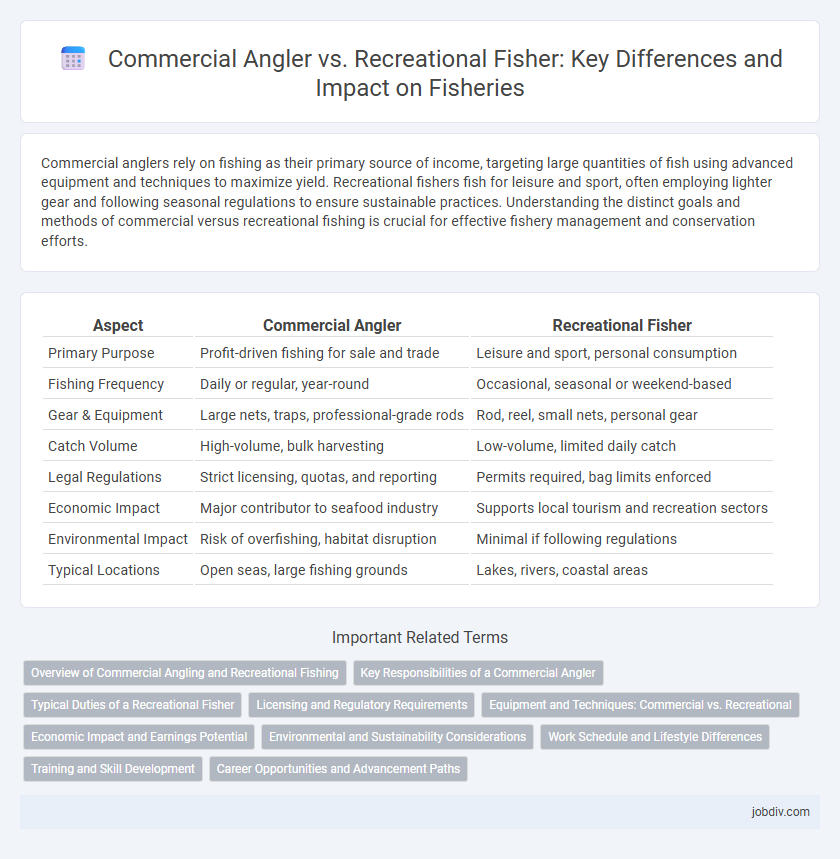Commercial anglers rely on fishing as their primary source of income, targeting large quantities of fish using advanced equipment and techniques to maximize yield. Recreational fishers fish for leisure and sport, often employing lighter gear and following seasonal regulations to ensure sustainable practices. Understanding the distinct goals and methods of commercial versus recreational fishing is crucial for effective fishery management and conservation efforts.
Table of Comparison
| Aspect | Commercial Angler | Recreational Fisher |
|---|---|---|
| Primary Purpose | Profit-driven fishing for sale and trade | Leisure and sport, personal consumption |
| Fishing Frequency | Daily or regular, year-round | Occasional, seasonal or weekend-based |
| Gear & Equipment | Large nets, traps, professional-grade rods | Rod, reel, small nets, personal gear |
| Catch Volume | High-volume, bulk harvesting | Low-volume, limited daily catch |
| Legal Regulations | Strict licensing, quotas, and reporting | Permits required, bag limits enforced |
| Economic Impact | Major contributor to seafood industry | Supports local tourism and recreation sectors |
| Environmental Impact | Risk of overfishing, habitat disruption | Minimal if following regulations |
| Typical Locations | Open seas, large fishing grounds | Lakes, rivers, coastal areas |
Overview of Commercial Angling and Recreational Fishing
Commercial angling involves fishing activities conducted for profit, targeting large quantities of fish through methods like trawling, longlining, and netting, often regulated by quotas to maintain sustainable fish stocks. Recreational fishing, by contrast, is primarily for leisure or sport, typically using rods and reels, with strict limits on catch size and species to protect aquatic ecosystems. Both sectors contribute to the fishing industry but have distinct impacts on marine resources and require different management approaches to balance economic benefits and conservation efforts.
Key Responsibilities of a Commercial Angler
Commercial anglers are responsible for catching large quantities of fish to supply markets, ensuring sustainable fishing practices to prevent overfishing, and adhering to strict regulations regarding fishing quotas and equipment. They handle the operation and maintenance of commercial fishing vessels, manage the preservation and storage of the catch to maintain quality, and document their harvests accurately for compliance and reporting. Their role also involves navigating fishing zones, optimizing catch efficiency, and ensuring safety protocols for crew members during extended sea expeditions.
Typical Duties of a Recreational Fisher
Recreational fishers primarily engage in fishing for personal enjoyment, often targeting species such as bass, trout, and salmon in freshwater or coastal environments. Their typical duties include selecting appropriate fishing gear, adhering to local fishing regulations and catch limits, and practicing catch-and-release techniques to promote conservation. Unlike commercial anglers, recreational fishers focus on sustainable and responsible practices that enhance sportfishing experiences while minimizing environmental impact.
Licensing and Regulatory Requirements
Commercial anglers must obtain specific fishing licenses and adhere to stringent regulatory requirements, including reporting catches and following quota limits set by fisheries management authorities. Recreational fishers typically require a more basic fishing license, with regulations focusing on size and bag limits to preserve fish populations. Compliance with these licensing and regulatory frameworks ensures sustainable fishery practices and legal accountability in both sectors.
Equipment and Techniques: Commercial vs. Recreational
Commercial anglers utilize heavy-duty nets, trawlers, and sophisticated sonar technology to capture large quantities of fish efficiently, focusing on maximizing yield for market supply. Recreational fishers prefer lightweight rods, reels, and bait techniques tailored for sport and personal enjoyment, often targeting specific species with methods like fly fishing or trolling. Equipment durability and scale of operation distinctly separate commercial fishing's industrial approach from the more selective, skill-based techniques of recreational fishing.
Economic Impact and Earnings Potential
Commercial anglers generate significant economic impact through large-scale fish harvesting, supplying seafood markets and supporting processing industries, with earnings dependent on catch volume and market prices. Recreational fishers contribute to local economies via tourism, equipment sales, and licensing fees, often generating substantial seasonal revenue but typically earning less directly from fishing activities. The economic potential for commercial anglers is higher due to continuous operations and bulk sales, whereas recreational fishing fuels economic activity indirectly through consumer spending.
Environmental and Sustainability Considerations
Commercial anglers utilize large-scale gear and methods, which can lead to overfishing and habitat disruption, raising significant environmental concerns regarding ecosystem balance and fish population sustainability. Recreational fishers typically engage in catch-and-release practices and have less impact on fish stocks, making them a more sustainable option when managed properly through regulations and seasonal restrictions. Both sectors require stringent monitoring and adherence to conservation policies to protect aquatic biodiversity and ensure long-term fishery health.
Work Schedule and Lifestyle Differences
Commercial anglers typically adhere to rigorous, often irregular work schedules that involve early mornings, long hours, and days at sea, driven by quotas and seasons crucial for economic sustainability. Recreational fishers enjoy flexible, leisure-oriented schedules, often fishing during weekends or holidays, emphasizing relaxation and sport over yield. The lifestyle of commercial anglers is labor-intensive and reliant on weather and market demands, whereas recreational fishers prioritize enjoyment and social experiences around fishing activities.
Training and Skill Development
Commercial anglers undergo intensive training programs emphasizing advanced navigation, fish behavior analysis, and sustainable harvesting techniques, ensuring high efficiency and compliance with fishing regulations. Recreational fishers typically acquire skills through informal learning, practice, and occasional guided instruction, focusing on catch-and-release methods and species identification for sport. Structured certification courses and workshops are increasingly available to enhance both groups' proficiency, promoting responsible fishing practices and safety at sea.
Career Opportunities and Advancement Paths
Commercial anglers often access stable career opportunities with roles such as deckhands, vessel operators, and fish processors, offering clear advancement through experience and certification. Recreational fishers typically pursue careers in guiding, charter services, or fishery management, with progression linked to skill development, local licenses, and customer service expertise. Both paths benefit from knowledge of sustainable practices, regulatory compliance, and evolving marine technology to enhance career growth.
Commercial Angler vs Recreational Fisher Infographic

 jobdiv.com
jobdiv.com